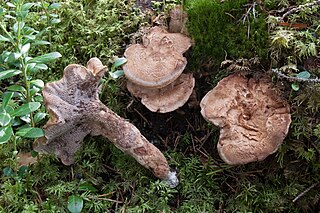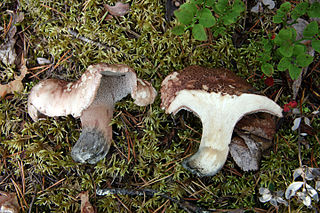Woodwardopterus is a genus of prehistoric eurypterid classified as part of the family Mycteroptidae. The genus contains one species, W. scabrosus, from the Carboniferous of Glencartholm, Scotland.

Mastigoproctus giganteus, the giant whip scorpion, also called the giant vinegaroon or grampus, is a species of whip scorpions in the family Thelyphonidae.

Carabus scabrosus, common name huge violet ground beetle, is a species of beetles of the family Carabidae.
Uzelothrips is a genus of thrips, and the only genus in the family Uzelothripidae. Up until 2012 it contained a single species, U. scabrosus, known from Belém, Brazil; Brisbane, Australia; Singapore, and Angola. In 2012 a new extinct species, U. eocenicus, was described from the lowermost Eocene of France by Patricia Nel and André Nel in 2012. The species name refers to the age it existed in. The group name is in honour of Jindřich Uzel, a Czech entomologist who published the first monograph on the thrips. The family is identified by the whip-like tip to the antenna.

Notochthamalus scabrosus, the only species in the genus Notochthamalus, is a species of barnacle found along the south-western and south-eastern coasts of South America, from Peru to the Falkland Islands. The species is found almost exclusively higher in the intertidal zone than the mussel Perumytilus, often codistributed with the confamilial barnacle Chthamalus cirratus and Balanus flosculus.

Clanculus scabrosus is a species of sea snail, a marine gastropod mollusk in the family Trochidae, the top snails.
Gondwanasuchus is an extinct genus of baurusuchid mesoeucrocodylian from the Late Cretaceous Adamantina Formation of Brazil. The type species is Gondwanasuchus scabrosus.
Scleronotus is a genus of beetles in the family Cerambycidae, containing the following species:

Hydnellum fennicum is a species of tooth fungus in the family Bankeraceae. It was originally described by Petter Karsten in 1882 as a variety of Sarcodon scabrosus. Karsten promoted it to a distinct species in 1887. It is considered critically endangered in Switzerland.
Potemnemus scabrosus is a species of beetle in the family Cerambycidae. It was described by Olivier in 1790. It is known from Papua New Guinea and Indonesia.

Lithurgus is a genus of woodborer bees in the family Megachilidae. There are more than 40 described species in Lithurgus.
Sixeonotus is a genus of plant bugs in the family Miridae. There are more than 30 described species in Sixeonotus.
Crophius scabrosus is a species of true bug in the family Oxycarenidae. It is found in Central America and North America.
Crophius is a genus of true bugs in the family Oxycarenidae. There are about 16 described species in Crophius.
Hexacylloepus is a genus of riffle beetles in the family Elmidae. There are about 19 described species in Hexacylloepus.
Elateropsis scabrosus is a species of long-horned beetle in the family Cerambycidae. It is found in the Caribbean Sea and North America.
Apteromechus is a genus of hidden snout weevils in the beetle family Curculionidae. There are more than 20 described species in Apteromechus.
Ametor latus is a species of water scavenger beetle in the family Hydrophilidae. It is found in North America.
Ametor is a genus of water scavenger beetles in the family Hydrophilidae. There are at least two described species in Ametor.

Hydnellum scabrosum, also called bitter tooth or bitter hedgehog, is a species of tooth fungus in the family Bankeraceae.








